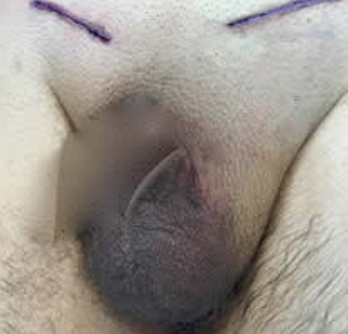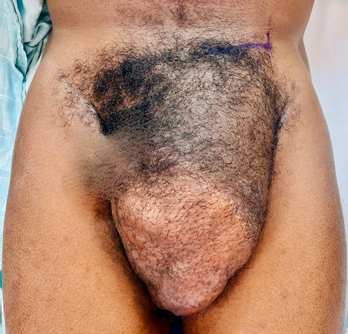No-Mesh Inguinal Hernia Repair in Fort Myers, Florida
Nomeshinaround – Using your own muscle to repair the inguinal floor or abdominal wall
Desarda Hernia Center of the United States®
No-Mesh Hernia Surgery in Florida
Schedule Your Appointment to Learn About Discounted Inguinal Hernia Repair Surgery in Florida
If you are researching no-mesh procedures for groin or inguinal hernias, you’ve found your answer. A trip to our practice in Fort Myers, Florida, can save you from the risks of placing mesh in your groin area. Schedule your consultation online to learn more about the Desarda technique and save $300. Or, give us a call at 1-888-884-0019. You can also view our testimonials online. Don’t go anywhere else, because we are the only certified center in the United States endorsed by Dr. Mohan Desarda.
IF YOU HAVE A HERNIA – CONTACT US FOR A CONSULTATION.
CALL TODAY FOR A FREE CONSULTATION
If you are struggling with the pain and discomfort of a groin hernia, it’s time to learn about the best-kept secret in hernia surgery — the Desarda technique. Dr. Robert Tomas of U First Health and the Desarda Hernia Center of the United States® is an expert in this cutting-edge procedure. From our Florida practice, Dr. Tomas has performed more than 4,000 small and large inguinal hernia surgeries using the Desarda method.

Board Certified General Surgeon
AAAASF Certified Surgical Center
Fort Myers, Florida
What Are Inguinal Hernias?
Inguinal hernias are a common type of adult hernia and occur more in men than in women. An inguinal hernia can develop when parts of the abdomen, such as the intestine, protrude through a weak spot in the abdominal muscles. This bulge usually creates pain, especially when you bend over, lift heavy objects or cough.
Inguinal hernias are located in the lower abdomen near the pubic area just above the crease of your leg. A direct inguinal hernia protrudes forward when you stand. Indirect hernias, on the other hand, often take a more sloping route toward the scrotum.
Causes of Inguinal Hernias
The weakened abdominal lining that leads to inguinal or femoral hernias often occurs at birth. The inguinal canal is where a male’s testicles descend before birth. If this part of the abdominal wall doesn’t seal properly, it can leave a natural defect called the internal inguinal ring.
Other causes of inguinal hernias include:
-
- Aging
- Strenuous physical activity
- Coughing due to smoking
- Straining during bowel movements or urination
- Pregnancy
- Chronic coughing or sneezing
Symptoms of Inguinal Hernias
The most common symptoms of an inguinal hernia include:
- Pain or discomfort in your groin that usually worsens when you bend over, cough or lift anything
- Weakness or pressure in your groin
- Dragging or a heavy feeling in your groin
- A bulge on either side of your pubic bone
- Burning or aching at the bulge
- Pain or swelling around the testicles
What Is Inguinal Hernia Repair?
While an inguinal hernia isn’t necessarily dangerous, it will not improve without treatment. It can also lead to severe complications. Groin hernia repair is a commonly performed surgery — thanks to the no-mesh Desarda technique, these groin hernia surgeries are safer than ever.
Traditionally, surgical mesh is used after the hernia is pushed back in place to provide extra support to the weakened abdominal muscles. However, mesh is a foreign body and has a long history of defects and recalls that put patients at risk. It can also shrink over time, leaving you unprotected and often leading to a hernia recurrence.
What Is the Desarda Technique for Inguinal Hernia Repair? Why Do We use the term Nomeshinaround?
Dr. Tomas can repair your hernia without mesh using the Desarda technique. A Desarda repair uses your own muscle tissue and two rows of absorbable sutures as strong and natural replacements for mesh. Incorporating the muscle strip into the hernia repair will not result in muscle weakness or deformity.
How Does It Work?
Whether you require direct or indirect inguinal hernia repair, Dr. Tomas uses a muscle graft. When you have an inguinal hernia, soft tissue — often the intestine or stomach — pushes the muscle that covers it. The Desarda repair technique uses a portion of the aponeurosis of the external oblique to cover this hole. Healthy oblique muscles provide support for the repaired hernia and also protect and cover the exposed organ.
What Are the Benefits of No-Mesh and Tension-Free Inguinal Hernia Repair?
The Desarda technique for hernia repair provides many benefits over other hernia repair procedures:
- No mesh-related risks: Even though surgical mesh is supposed to be safe, it can have unpredictable effects. This includes pain, rejection, hernia recurrence, infection, migration and even testicular damage. The Desarda procedure uses your own muscle for the repair to support the inguinal floor, reducing and often eliminating these risks.
- Low tension: While there are other mesh-free hernia techniques, these involve pulling on the edges of the hernia to close it, causing tension. The Desarda technique avoids this by using a muscle graft as a bridge between the ligament and oblique muscle. This new support uses your own tissue and doesn’t rely on tension.
- Low risk of recurrence: Dr. Tomas has performed more than 4,000 no-mesh inguinal hernia surgeries with less than a 1% risk of recurrence.
- Absorbable sutures: Traditional femora hernia repair relies on stainless steel sutures. Instead of using devices that remain in your body, Dr. Tomas employs absorbable sutures that dissolve with time.
- Flat rate: No need to worry about copays or whether your insurance covers this procedure. We offer our inguinal hernia repairs without mesh for a flat fee.


Testimonials
 Garr RVery happy with the staff, the process and the results
Garr RVery happy with the staff, the process and the results Joni UptegroveI wanted to wait before writing a review to make sure that I didn't ever have any issues. I had my surgery in May of 2021 and it was a truly wonderful experience. The entire staff was so kind and knowledgeable, from the very beginning to the very end. I did a ton of research about mesh beforehand and ultimately decided that mesh was not the way to go for me personally. Here are the things that I think helped my surgery go smoothly. I had a very small (10mm) umbilical hernia as well as diastasis recti (which caused the hernia I'm sure). Prior to surgery I did an ab rehab program that helped heal my diastasis almost completely. It's a 12 week program (by Nancy Anderson), I got through 7 weeks before my surgery date. I think it helped strengthen my abs so much which helped with recovery. I did a lot of walking and didn't wear the binder for very long. My angel of a mom went with me so I had someone to help me navigate the airport, help me get around, remember my pain meds etc. Nearly 3 years later I have a tiny scar but have had absolutely zero issues. It's like it never even happened! I've been in various states of active since then from super active mountain hunting to couch slug lol and no problems whatsoever. I turned it in to my insurance and they did partially reimburse it. Follow their recovery instructions, try to strengthen your core before and after your surgery, and take care of your body with good nutrition and hydration and I think you'll be very glad you went mesh-free with Dr. Tomas!!
Joni UptegroveI wanted to wait before writing a review to make sure that I didn't ever have any issues. I had my surgery in May of 2021 and it was a truly wonderful experience. The entire staff was so kind and knowledgeable, from the very beginning to the very end. I did a ton of research about mesh beforehand and ultimately decided that mesh was not the way to go for me personally. Here are the things that I think helped my surgery go smoothly. I had a very small (10mm) umbilical hernia as well as diastasis recti (which caused the hernia I'm sure). Prior to surgery I did an ab rehab program that helped heal my diastasis almost completely. It's a 12 week program (by Nancy Anderson), I got through 7 weeks before my surgery date. I think it helped strengthen my abs so much which helped with recovery. I did a lot of walking and didn't wear the binder for very long. My angel of a mom went with me so I had someone to help me navigate the airport, help me get around, remember my pain meds etc. Nearly 3 years later I have a tiny scar but have had absolutely zero issues. It's like it never even happened! I've been in various states of active since then from super active mountain hunting to couch slug lol and no problems whatsoever. I turned it in to my insurance and they did partially reimburse it. Follow their recovery instructions, try to strengthen your core before and after your surgery, and take care of your body with good nutrition and hydration and I think you'll be very glad you went mesh-free with Dr. Tomas!! Erik MateoI wanted to share my experience because going over the reviews and information about u first was very helpful in making a decision. I had hernia surgery July of 2022 and the whole experience was 10 of 10 from staff to doctors. Iam a very active person and was scared of not living that lifestyle after finding out I had a hernia but Iam happy say that Iam back to 100% and feeling great. Make sure to listen to what the staff and doctors say for recovery and give yourself time to heal ( one step at a time) everything will be ok. Hope this helps make someone feel a bit more at ease knowing I know exactly what your going through.
Erik MateoI wanted to share my experience because going over the reviews and information about u first was very helpful in making a decision. I had hernia surgery July of 2022 and the whole experience was 10 of 10 from staff to doctors. Iam a very active person and was scared of not living that lifestyle after finding out I had a hernia but Iam happy say that Iam back to 100% and feeling great. Make sure to listen to what the staff and doctors say for recovery and give yourself time to heal ( one step at a time) everything will be ok. Hope this helps make someone feel a bit more at ease knowing I know exactly what your going through. Eric MThis may be the best medical facility I have ever encountered, and I've been around for a long time. Alina was the first person I had conversations with and she was very helpful and caring. By the time I had my inguinal hernia surgery in Oct, 2023, I saw that everyone working there had the same friendly compassion and desire to see that I was happy in the process. I had to go to the Colonial Center because of my age and everyone there was also wonderful. Of course the most important thing is the Doctor's ability and manner; they were all professional and masters of their trade. I only took the pain pills for 4 days and I am almost back to normal, now that 6 weeks have gone by. I'm afraid to make any jerky, twisting moves, so I will wait until the second week of Dec. to play golf. A few years ago a golf pro was analyzing my swing and he said I "looked like a gorilla having a seizure." That sounds like the time I could tear some sutures. Anyway, I highly recommend UFirstHealth and wish I went there sooner than I did. Eric M
Eric MThis may be the best medical facility I have ever encountered, and I've been around for a long time. Alina was the first person I had conversations with and she was very helpful and caring. By the time I had my inguinal hernia surgery in Oct, 2023, I saw that everyone working there had the same friendly compassion and desire to see that I was happy in the process. I had to go to the Colonial Center because of my age and everyone there was also wonderful. Of course the most important thing is the Doctor's ability and manner; they were all professional and masters of their trade. I only took the pain pills for 4 days and I am almost back to normal, now that 6 weeks have gone by. I'm afraid to make any jerky, twisting moves, so I will wait until the second week of Dec. to play golf. A few years ago a golf pro was analyzing my swing and he said I "looked like a gorilla having a seizure." That sounds like the time I could tear some sutures. Anyway, I highly recommend UFirstHealth and wish I went there sooner than I did. Eric M Paul SpanielThey did hernia surgery on me in 3 day deal. It worked no more problems.
Paul SpanielThey did hernia surgery on me in 3 day deal. It worked no more problems. erik gallagherAmazing friendly staff. Awesome doctor. Everyone there was so great. Wonderful experience. Only part of having a hernia I enjoyed was meeting such great people. Thank you to everyone there, you all are masters at what you do. Keep it up! Update one month later: It's almost as though I didn't even have the surgery. The only evidence is an incision ridge, normal, and the hernia being gone. I can cough without a bulge. No heavy feeling down there. No pain. I am ecstatic and grateful for the staff at ufirst. I would have never allowed mesh inside of me, it was dealing with it until it was an emergency and nothing else. I watched the procedure and concluded that I agree with this method as it is logical and should be the gold standard. I feel great and thank you all again and again. Update 6 months later: zero pain, zero discomfort, feeling completely normal, almost like the hernia was never there. I had phantom feelings of it being there, and nightmares, but I believe it was because it was gone as fast as I had gotten it. One day it's there and the next it is gone. I got through the mental anguish by staying positive and trusting the process, visualizing the healing that was taking place. The doctor and staff did their job and I as well and everything came together perfectly. I am eternally grateful for such an amazing experience. Been over a year now, feeling normal. Thank you again!
erik gallagherAmazing friendly staff. Awesome doctor. Everyone there was so great. Wonderful experience. Only part of having a hernia I enjoyed was meeting such great people. Thank you to everyone there, you all are masters at what you do. Keep it up! Update one month later: It's almost as though I didn't even have the surgery. The only evidence is an incision ridge, normal, and the hernia being gone. I can cough without a bulge. No heavy feeling down there. No pain. I am ecstatic and grateful for the staff at ufirst. I would have never allowed mesh inside of me, it was dealing with it until it was an emergency and nothing else. I watched the procedure and concluded that I agree with this method as it is logical and should be the gold standard. I feel great and thank you all again and again. Update 6 months later: zero pain, zero discomfort, feeling completely normal, almost like the hernia was never there. I had phantom feelings of it being there, and nightmares, but I believe it was because it was gone as fast as I had gotten it. One day it's there and the next it is gone. I got through the mental anguish by staying positive and trusting the process, visualizing the healing that was taking place. The doctor and staff did their job and I as well and everything came together perfectly. I am eternally grateful for such an amazing experience. Been over a year now, feeling normal. Thank you again! C GDr. Tomas and his team are OUTSTANDING! From the first phone call I ever made to U First Health & Rejuvenation regarding my husband's hernia issue, (with Debra) I felt like I had an advocate. Dr. Tomas is knowledgeable, experienced and totally proficient. He repaired all three of my husband's hernias with an expertise that only comes from years of experience working in his field. Every single member of his team is available, knowledgeable, patient, positive and supportive. Prior to arriving, Debra walked us through the entire process from start to finish, and once we were at the clinic we were impressed with the way everyone involved worked together so harmoniously. We live in Texas and had to travel to Florida for the procedure, but it was worth every effort, time and dollar spent to have such great care. We are sincerely grateful that because of Dr. Tomas' work, we had an alternative to standard mesh hernia surgery. Thank you Dr. Tomas and the whole team!
C GDr. Tomas and his team are OUTSTANDING! From the first phone call I ever made to U First Health & Rejuvenation regarding my husband's hernia issue, (with Debra) I felt like I had an advocate. Dr. Tomas is knowledgeable, experienced and totally proficient. He repaired all three of my husband's hernias with an expertise that only comes from years of experience working in his field. Every single member of his team is available, knowledgeable, patient, positive and supportive. Prior to arriving, Debra walked us through the entire process from start to finish, and once we were at the clinic we were impressed with the way everyone involved worked together so harmoniously. We live in Texas and had to travel to Florida for the procedure, but it was worth every effort, time and dollar spent to have such great care. We are sincerely grateful that because of Dr. Tomas' work, we had an alternative to standard mesh hernia surgery. Thank you Dr. Tomas and the whole team! Christos DaskalakisI had bilateral Inguinal surgery about 1 year ago in 2022 with Dr. Tomas and it was the best decision I ever made. Doctor Tomas is a brilliant surgeon. The procedure went great and the staff were very friendly and professional. I did a lot of research before and it seemed like a logical choice. I was up walking the same day but recovery took about a month. Although to get back to working out took like 4 months. I am 60 so not a spring chicken, LOL. Overall, a great experience. I just wished he was closer to me and insurance covered it, but at least the outpatient and the anesthesiologist was paid by my insurance. I also tried to put it through Blue Cross, and they said it can be done, but after several attempts, they still have not reimbursed me. But I will keep bugging them!!!
Christos DaskalakisI had bilateral Inguinal surgery about 1 year ago in 2022 with Dr. Tomas and it was the best decision I ever made. Doctor Tomas is a brilliant surgeon. The procedure went great and the staff were very friendly and professional. I did a lot of research before and it seemed like a logical choice. I was up walking the same day but recovery took about a month. Although to get back to working out took like 4 months. I am 60 so not a spring chicken, LOL. Overall, a great experience. I just wished he was closer to me and insurance covered it, but at least the outpatient and the anesthesiologist was paid by my insurance. I also tried to put it through Blue Cross, and they said it can be done, but after several attempts, they still have not reimbursed me. But I will keep bugging them!!! Dayne SilverbergCurrently two weeks after my inguinal hernia repair and I am almost completely back to normal. I was nervous about getting this procedure because I’d never had surgery before but the staff at Ufirst made everything so easy and I felt comfortable through the entire process. The recovery wasn’t bad and I am so thankful to be mesh free. I highly recommend Dr. Tomas and the crew here if you have a hernia that needs fixing, you won’t regret it.Google rating score: 4.5 of 5, based on 42 reviews
Dayne SilverbergCurrently two weeks after my inguinal hernia repair and I am almost completely back to normal. I was nervous about getting this procedure because I’d never had surgery before but the staff at Ufirst made everything so easy and I felt comfortable through the entire process. The recovery wasn’t bad and I am so thankful to be mesh free. I highly recommend Dr. Tomas and the crew here if you have a hernia that needs fixing, you won’t regret it.Google rating score: 4.5 of 5, based on 42 reviews

U First Health is also the Desarda Hernia Center of the United States®
Our Florida practice has served more than 4,000 patients from across the U.S. and around the world. Dr. Robert Tomas and our team specialize in inguinal hernia surgery procedures in Florida, delivering outstanding results with a low risk of postoperative complications and recurrence.
About Dr. Robert Tomas
Robert E. Tomas, D.O., FACOS, is recognized by Dr. Mohan Desarda as the only provider of Desarda hernia repair in the United States. Dr. Tomas is board certified in general surgery and has more than 20 years of experience. For over a decade now, he has performed inguinal surgery repairs in Florida, providing thousands of patients with exceptional results and life-changing relief.
CALL TODAY FOR A FREE CONSULTATION about No-Mesh Inguinal Hernia Repair
What Is the Process of Getting Inguinal Hernia Surgery?
Before your Desarda procedure, our Florida team will ensure you understand what you can expect as one of our hernia repair patients. We can arrange your free consultation with Dr. Tomas in person or over the phone. We also use preoperative bloodwork and an EKG to ensure you’re eligible for surgery.
Dr. Tomas and his team will perform your Desarda hernia repair under local or general anesthesia, depending on your preferences and health profile.
Our team will then guide you regarding all aftercare instructions to ensure you enjoy a rapid and safe recovery. A few days after your surgery, Dr. Tomas will check your incision and monitor your healing. Out-of-town patients can return home after this appointment. Most patients go back to work one week after their procedure.
Click on the link below to register for our TouchMD app.
This will guide you through your surgery:
WARNING: Graphic content. Large Inguinal Hernia.
Here you see a hernia protruding from the floor of the inguinal canal. As you can see there is a defect in the floor resulting in a direct hernia.

The first row of sutures is used to cover the defective floor of the inguinal canal and as you can see the hernia sac is no longer visible.
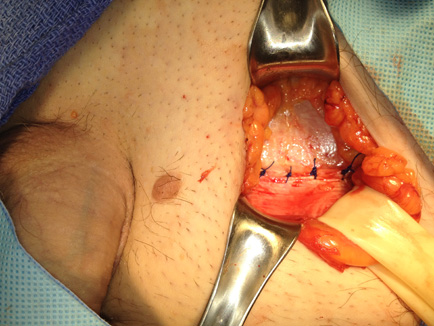
Then, to reinforce the floor, a second row of sutures is used with the adjacent muscle belly of the inguinal canal.

Illustration Steps of the Desarda Technique


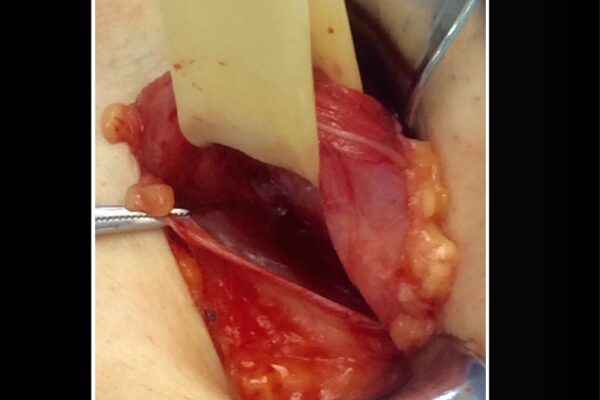




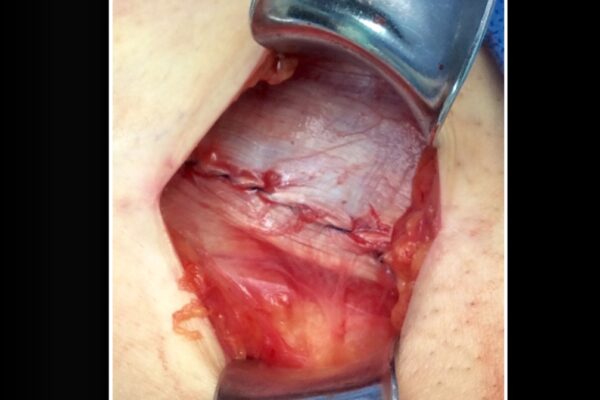

Desarda Hernia Center, USA | NoMeshHerniaSurgery.com
Case Study #1
72 YM who flew dwn from New Hampshire with extremely large bilateral inguinal hernias for over 25 years and wished to have them repaired with No Mesh, Desarda Technique. Performed by Dr. Robert Tomas. This man is confirmed to have no recurrence 6 years later, July, 2022.


Case Study #2
44 YM who presented to the emergency room in excruciating pain and a large inguinal hernia on the right that was extremely large and under pressure. A second incision on the right scrotum was needed in order to reduce the intestines. He wished to have it repaired with No Mesh, Desarda Technique. This surgery was performed by Dr. Robert Tomas as an emergency at Gulf Coast Medical Center.


Case Study #4
A 64 YM came down from northern Florida with this large hernia that had an obvious large section of his intestine in his scrotum. He did not want mesh at all, so he came to the Desarda Hernia Center, USA® . The surgery was performed under general anesthesia in order to reduce a large section of the small intestine and right colon back into the peritoneal (belly) cavity. It was performed by Robert Tomas, D.O, FACOS in Novemeber, 2015 with no mesh. Even these large hernias can be repaired with the Desarda technique.
Case Report
45 year old male complaining of pain for several years after inguinal hernia mesh repair. He was unable to play hockey without pain. Dr. Robert Tomas recommended mesh removal. He was pain free after the surgery. Please note the reconstructed floor of the inguinal canal after mesh removal. Strength of the floor is the patient’s own external oblique muscle strip.
Performed by Dr. Robert Tomas
A Recent testimonial from a patient from Tampa, FL that came down for a No Mesh Tension Free Inguinal Hernia Repair (Desarda Technique):
K. Morin wrote:
When I was first diagnosed with a hernia by my urologist and started doing research, I became very disconcerted when it appeared that the main method used consisting of mesh and staples only had a 47% success rate….meaning the surgery has long term failure rate of almost half.
I am very active at 58 as I have an 8 year old son and I coach/play baseball, football and basketball with him, go wave running, snowmobiling….not to mention wrestling and the flying leaps that an 8 year old takes…failing to realize of course that he weighs 64 pounds and his dad is old.
Through continued research, and a stroke of luck, I discovered the Desarda, no mesh, tension free method and Dr. Tomas at Ufirsthealth. I started doing more research and discovered that it had a tremendous success rate so I contacted Ufirsthealth and sent an email under the “Ask the doctor” icon. Within a half hour, Dr. Tomas responded and gave me a number to call him at so he could explain the surgery to me. I called, he answered, and spent about ten minutes on the phone with me explaining the procedure. That was a first.
I drove to Ft Myers and found the entire staff to be “first rate” and when I met Dr. Tomas, his demeanor alone gave me all the comfort and confidence I needed and had the surgery done the next day. About two hours after my arrival, I was on my way home to Tampa, feeling great considering I just had surgery and outside of normal discomfort associated with any type of surgery, I had no issues whatsoever and was back on my treadmill the second day after surgery.
After three weeks, feeling great, almost back to normal activities and I have nothing but accolades regarding the procedure, Dr. Tomas and his first class team of professionals.
Thanks so much. (Read more testimonials)












